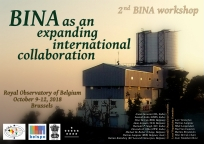Speaker
Prof.
Anandmayee Tej
(Indian Institute of Space Science and Technology, Thiruvananthapuram, India)
Description
An investigation in radio and infrared wavelengths of two high-mass star-forming regions toward the southern Galactic bubble S10 is presented in this work. The two regions under study are associated with the broken bubble S10 and Extended Green Object, G345.99-0.02, respectively. Radio continuum emission mapped at 610 and 1280 MHz using the Giant Metrewave Radio Telescope, India, is detected toward both of the regions. These regions are estimated to be ionized by early-B- to late-O-type stars. Spitzer GLIMPSE mid-infrared data is used to identify young stellar objects (YSOs) associated with these regions. A Class-I/II-type source, with an estimated mass of 6.2 Msun, lies ~7′′ from the radio peak. Pixel-wise, modified blackbody fits to the thermal dust emission using Herschel far-infrared data is performed to construct dust temperature and column density maps. Eight clumps are detected in the two regions using the 250 μm image. The masses and linear diameter of these range between ~300–1600 Msun and 0.2–1.1 pc, respectively, which qualifies them as high-mass star-forming clumps. Modeling of the spectral energy distribution of these clumps indicates the presence of high luminosity, high accretion rate, massive YSOs possibly in the accelerating accretion phase. Furthermore, based on the radio and mid-infrared morphology, the occurrence of a possible bow wave toward the likely ionizing star is explored.
Primary author
Mr
Swagat Ranjan Das
(Indian Institute of Space Science and Technology)
Co-authors
Dr
Anandmayee Tej
(Indian Institute of Space Science and Technology)
Dr
Ishwara Chandra C.H.
(National Centre For Radio Astrophysics)
Dr
Sarita Vig
(Indian Institute of Space Science and Technology)
Prof.
Swarna K. Ghosh
(National Centre For Radio Astrophysics)

